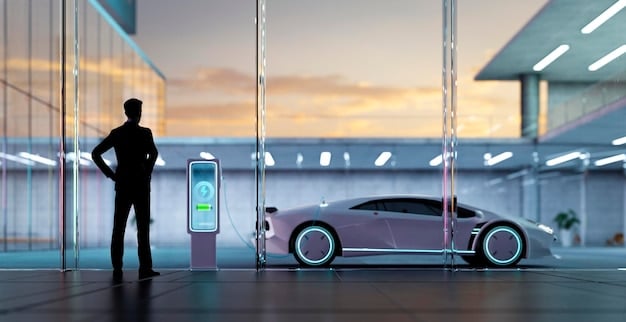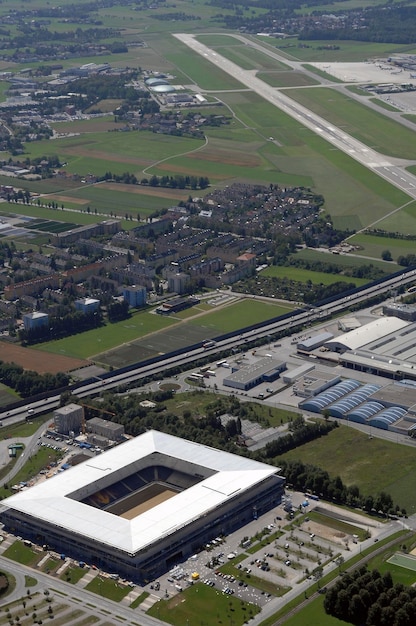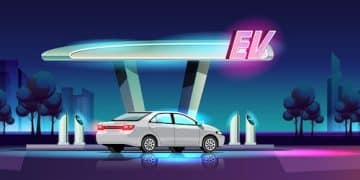EV tech’s impact on US auto industry

The advent of electric vehicle technology is substantially reshaping the US automotive industry, driving innovation, supply chain reconfigurations, and significant shifts in consumer preferences and manufacturing paradigms.
The automotive landscape in the United States is undergoing a profound transformation, propelled by the rapid advancements and widespread adoption of electric vehicle (EV) technology. This shift is not merely an incremental change but a fundamental reshaping of an industry that has defined American manufacturing and culture for over a century. The impact of electric vehicle technology on the US automotive industry extends far beyond just the assembly line, influencing everything from supply chains and labor markets to consumer expectations and global competitiveness. Understanding this multifaceted evolution is crucial for anyone keen on the future of transportation and the broader economic implications in the US.
The electrification revolution: A paradigm shift
The transition to electric vehicles represents a monumental shift for the US automotive sector, moving away from a long-standing reliance on internal combustion engines. This revolution is driven by a confluence of factors, including growing environmental concerns, volatile fossil fuel prices, technological breakthroughs, and supportive government policies.
The initial phase of EV integration saw niche players and startups leading the charge, but now established giants of the auto industry are committing enormous resources to electrification. This commitment is reshaping production lines, forcing companies to re-evaluate their core competencies, and demanding significant investment in research and development for battery technology, charging infrastructure, and software integration.
Driving forces behind EV adoption
- 🚀 **Environmental Imperative:** The urgent need to reduce carbon emissions and combat climate change is a primary motivator. EVs offer a significant reduction in tailpipe emissions, contributing to cleaner air and a smaller carbon footprint.
- 💰 **Economic Incentives:** Government subsidies, tax credits, and various consumer incentives play a crucial role in making EVs more affordable and attractive to the broader public. These incentives aim to accelerate market adoption.
- ⚡ **Technological Advancements:** Continuous improvements in battery density, charging speeds, and range have made EVs increasingly practical for everyday use, addressing many of the “range anxiety” concerns that once hindered adoption.
- 🌐 **Global Competition:** The global race to dominate the EV market is pushing US manufacturers to innovate rapidly, not only to meet domestic demand but also to compete effectively on the international stage, particularly with strong contenders from Asia and Europe.
This paradigm shift is forcing a re-evaluation of every aspect of the automotive business model, from vehicle design to sales and service. Companies are grappling with the complexities of managing battery lifecycles, developing robust charging networks, and upskilling their workforce to handle new technologies. The industry’s future success hinges on its ability to adapt swiftly and strategically to these new demands.
Reshaping manufacturing and supply chains
The manufacturing process for electric vehicles differs significantly from traditional gasoline-powered cars, fundamentally altering the automotive supply chain. Batteries, electric motors, and power electronics replace complex engine blocks and transmissions, requiring new materials, production techniques, and a reorientation of existing infrastructure.
The sourcing of critical raw materials, particularly lithium, cobalt, and nickel for batteries, has become a major geopolitical and economic concern. The US automotive industry is actively working to establish more localized and resilient supply chains to mitigate risks associated with international dependencies and ensure a stable supply for burgeoning EV production targets.

Key changes in the manufacturing landscape
- 🏭 **Facility Transformation:** Many existing gasoline engine plants are being retooled and reconfigured for EV component production or full EV assembly. This requires substantial capital investment and strategic planning.
- 🔋 **Battery Production Hubs:** The US is seeing a surge in battery manufacturing facilities, often established through joint ventures between US automakers and international battery specialists, aiming to localize production and reduce costs.
- ⛓️ **Supply Chain Diversification:** Efforts are underway to diversify the sourcing of critical EV materials, including exploring domestic mining and refining capabilities, to reduce reliance on a few key global suppliers.
The shift also necessitates a focus on circular economy principles, particularly for battery recycling and second-life applications. Establishing robust recycling infrastructure for spent EV batteries is crucial to ensure sustainability and recover valuable materials, further reducing reliance on new raw material extraction. These strategic changes are not just about efficiency but also about building a more sustainable and secure foundation for the future of auto manufacturing.
Impact on labor and workforce development
The transition to electric vehicles has significant implications for the automotive workforce, presenting both challenges and opportunities. While some traditional jobs in engine and transmission manufacturing may decline, new roles are emerging in battery production, software development, charging infrastructure deployment, and EV maintenance.
The skills required for designing, building, and servicing EVs are distinct from those needed for internal combustion engine vehicles. This necessitates substantial investment in workforce training and re-skilling programs to ensure that the current labor force can adapt to the evolving demands of the industry.
Automakers, alongside government agencies and educational institutions, are collaborating to develop curricula and apprenticeship programs that equip workers with the necessary expertise in areas such as high-voltage electrical systems, battery management systems, and advanced software integration. This proactive approach is vital to prevent widespread job displacement and ensure a smooth transition for the workforce.
Addressing workforce challenges and opportunities
- 🎓 **Training and Up-skilling:** Programs are being developed to train existing automotive workers in EV-specific technologies, focusing on electrical systems, diagnostics, and software.
- 👩🔬 **New Job Creation:** The rapid growth of the EV sector is creating new job opportunities in battery manufacturing, charging infrastructure, research and development, and specialized EV maintenance.
- 🤝 **Union Adaptation:** Labor unions are actively engaged in negotiations with automakers to secure fair wages and job protections for workers during this industry transformation, ensuring a just transition.
The success of the EV transition hinges on the industry’s ability to cultivate a skilled workforce capable of innovating and maintaining these advanced vehicles. This investment in human capital is as critical as the investment in new factories and technologies, forming the backbone of a sustainable EV ecosystem.
Consumer adoption and market dynamics
The pace of electric vehicle adoption by US consumers is accelerating, driven by evolving perceptions, improving technology, and a growing understanding of the benefits. While initial adoption was slower due to factors like range anxiety and higher upfront costs, these barriers are steadily diminishing.
Consumer preferences are shifting, with a growing segment prioritizing sustainability, reduced running costs, and the advanced technological features often found in EVs. The increasing variety of EV models—from sedans and SUVs to pickup trucks—also contributes significantly to broadening their appeal and catering to diverse consumer needs.
The expansion of public and private charging infrastructure is another critical factor influencing consumer confidence. As charging becomes more accessible and faster, the practicality of owning an EV improves, encouraging more widespread adoption across different regions of the country.

Evolving consumer behavior and market trends
- 📈 **Accelerated Demand:** Sales figures indicate a clear upward trend in EV adoption, with projections suggesting continued rapid growth in the coming years as more models become available.
- 💲 **Cost of Ownership:** While upfront costs can be higher, EVs generally offer lower running costs due to cheaper electricity compared to gasoline and reduced maintenance requirements.
- 🗺️ **Charging Infrastructure Expansion:** Both private companies and government initiatives are investing heavily in building out a comprehensive national charging network, addressing one of the primary concerns for prospective EV owners.
The dynamic interplay between technological advancement, infrastructure development, and shifting consumer preferences will dictate the rate at which EVs become mainstream in the US. Automakers are therefore intensely focused on not only producing compelling EV models but also on educating consumers and supporting the necessary ecosystem for widespread adoption.
Policy, regulation, and infrastructure development
Government policies and regulations at both federal and state levels play a pivotal role in shaping the trajectory of electric vehicle adoption and manufacturing within the US automotive industry. These frameworks often include incentives for consumers and manufacturers, emission standards, and investments in critical infrastructure.
The push for stricter emission standards and fuel efficiency targets has significantly incentivized automakers to accelerate their EV development plans. Additionally, substantial federal funding has been allocated to build out a robust national EV charging network, a crucial element for mass adoption.
State-level initiatives, such as Zero-Emission Vehicle (ZEV) mandates and local tax credits, further reinforce the national electrification efforts, creating a varied but generally supportive regulatory environment across the country. The predictability and stability of these policies are vital for encouraging long-term investments from the automotive sector.
Key policy and infrastructure initiatives
- 🏛️ **Federal Incentives:** Tax credits for EV purchases and charging infrastructure installations are significant drivers of consumer adoption and industry investment.
- ⚡ **Charging Network Build-Out:** Massive investments are being made to construct a nationwide network of fast-charging stations, ensuring convenience and reducing range anxiety for EV drivers.
- ♻️ **Recycling and Sustainability Regulations:** Emerging regulations are focusing on the responsible disposal and recycling of EV batteries, promoting a circular economy approach for critical materials.
The synergy between government policy, private sector innovation, and infrastructural development is essential for realizing the full potential of the EV revolution. A supportive regulatory environment fosters investment and accelerates the transition, ensuring the US remains competitive in the global automotive landscape.
Innovation and technological advancements
The electric vehicle domain is a hotbed of innovation, driving rapid technological advancements that are continually improving EV performance, efficiency, and appeal. Battery technology, in particular, is undergoing revolutionary changes, promising longer ranges, faster charging times, and lower production costs.
Beyond batteries, significant progress is being made in electric motor design, power electronics, and regenerative braking systems, all contributing to more efficient and dynamic driving experiences. Software development is also becoming increasingly integral to EV functionality, from advanced infotainment systems to sophisticated battery management and autonomous driving features.
The automotive industry is seeing a convergence of technologies, with EVs serving as platforms for integrating artificial intelligence, advanced sensors, and connectivity features. This makes EVs not just a mode of transport but sophisticated mobile computing devices that are constantly evolving through over-the-air updates.
Breakthroughs shaping the future of EVs
- 🔋 **Solid-State Batteries:** Research into solid-state battery technology holds the promise of higher energy density, faster charging, improved safety, and potentially lower costs compared to current lithium-ion batteries.
- 🤖 **Advanced Driver-Assistance Systems (ADAS):** EVs are at the forefront of integrating sophisticated ADAS features and the development of fully autonomous driving capabilities, enhancing safety and convenience.
- 🌐 **Vehicle-to-Grid (V2G) Technology:** This emerging technology allows EVs to not only draw power from the grid but also feed excess electricity back into it, turning vehicles into mobile energy storage units that can support grid stability.
This relentless pace of innovation ensures that electric vehicles will continue to evolve rapidly, becoming more accessible, efficient, and integrated into the broader energy ecosystem. The US automotive industry’s commitment to funding and fostering these innovations will be crucial for maintaining its competitive edge.
The long-term economic outlook for the US auto industry
The long-term economic outlook for the US automotive industry, deeply intertwined with the success of its EV transition, appears robust despite significant short-term challenges. The shift to electric vehicles is not merely a product change but a fundamental economic restructuring with far-reaching consequences for investment, trade, and job creation.
While the transition requires substantial upfront investment in new factories and technologies, it also promises new revenue streams, especially from software-enabled services and charging infrastructure. The growth of the EV market has the potential to create a new competitive advantage for US manufacturers on the global stage, reducing reliance on fossil fuel imports and strengthening energy independence.
Furthermore, localizing the EV supply chain, from raw material processing to battery manufacturing, can stimulate regional economies and create high-tech manufacturing jobs. This strategic pivot positions the US automotive industry not just as a producer of cars, but as a leader in sustainable mobility solutions and advanced manufacturing.
Future economic landscape and opportunities
- 📈 **Market Growth:** Projections indicate sustained growth in the EV segment, opening new market opportunities for manufacturers, suppliers, and service providers.
- 💰 **Investment Inflow:** The focus on electrification is attracting significant domestic and international investment into US manufacturing facilities and R&D centers.
- 🌍 **Global Competitiveness:** By leading in EV technology and production, the US can maintain its position as a global automotive powerhouse, influencing international standards and trade.
The economic success of the US automotive industry in the coming decades will largely depend on its ability to navigate this complex transition, embrace innovation, and foster a supportive ecosystem for electric vehicles. The opportunities for growth and sustained prosperity are substantial, provided the industry continues to adapt with agility and strategic foresight.
| Key Aspect | Brief Description |
|---|---|
| 🚗💨 Manufacturing Shift | Transition from engine to battery production, requiring new facilities and supply chains. |
| 👷♀️🌐 Workforce Retraining | Upskilling labor for EV-specific technologies and creating new job roles. |
| 📈 Consumer Adoption | Growing demand driven by tech improvements, cost savings, and expanding charging infrastructure. |
| 💡🔋 Innovation Focus | Continuous R&D in battery tech, software, and autonomous features. |
Frequently asked questions (FAQs)
▼
EV technology significantly alters manufacturing by shifting focus from complex internal combustion engines to batteries and electric powertrains. This requires new production lines, specialized robotics, and a deeper emphasis on software integration. Many traditional engine plants are being retooled, leading to substantial re-investment in facilities and training for a new generation of manufacturing workers.
▼
The impact on the workforce is substantial: while some gasoline-related jobs may decline, new roles emerge in battery manufacturing, software development, and EV maintenance. This necessitates widespread reskilling and training programs to equip workers with expertise in high-voltage electrical systems and advanced diagnostics. Proactive collaboration between industry, government, and education is crucial for a smooth transition.
▼
Yes, generally, electric vehicles are more environmentally friendly over their lifecycle. While battery production has an environmental footprint, EVs produce zero tailpipe emissions, significantly reducing local air pollution. When powered by renewable energy sources, their overall carbon footprint is considerably lower than gasoline cars, contributing to cleaner air and a reduction in greenhouse gases.
▼
Government policies are pivotal. Federal and state incentives, such as tax credits for EV purchases and investments in charging infrastructure, directly encourage consumer adoption and manufacturer investment. Stricter emission standards also compel automakers to accelerate EV development. These policies create a supportive ecosystem, reducing costs for consumers and fostering a stable growth environment for the industry.
▼
Charging infrastructure is rapidly expanding to meet growing EV demand. Both public and private sector investments are accelerating the deployment of charging stations across the country, including fast chargers along major highways. Efforts are focused on increasing accessibility, reliability, and speed of charging to alleviate range anxiety and ensure convenience for EV owners everywhere.
Conclusion
The impact of electric vehicle technology on the US automotive industry is undeniable and continues to unfold with unprecedented speed. This isn’t merely a technological upgrade but a comprehensive transformation, redefining manufacturing processes, reshaping supply chains, and demanding a profound evolution of the workforce. While challenges such as raw material sourcing and infrastructure development persist, the industry’s commitment to innovation, coupled with supportive governmental policies and increasing consumer interest, paints a clear picture of a dynamic future. The US automotive sector is not just adapting to this new reality; it is actively shaping it, striving to maintain its global leadership in an era defined by sustainable mobility and cutting-edge technology. The journey ahead promises continued innovation, economic shifts, and a profound change in how Americans drive and perceive their vehicles.





